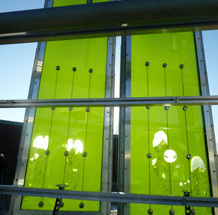
I was at an interesting presentation by Jan Wurm, Arups European Research Leader, organized by Materia at the international Building tradeshow “Bouwbeurs” in the Netherlands. He talked about the smart material house Arup is developing with partners Splitterwerk and others for the International Building tradeshow in Hamburg which opens March 22nd. The house is currently under construction in Hamburg and will be finished in 2-3 weeks time.
This zero-energy house is set to provide a real-life test for the world’s first bio-adaptive, a new façade system that uses live microalgae to provide shade and generate renewable energy at the same time. The façade concept is designed to let the algae in the bio-reactor façades grow faster in bright sunlight to provide more internal shading. The ‘bio-reactors’ not only produce biomass that can subsequently be harvested, but they also capture solar thermal heat – both energy sources will be used to power the building.
“To use bio-chemical processes for adaptive shading is a really innovative and sustainable solution so it is great to see it being tested in a real-life scenario. As well as generating renewable energy and providing shade to keep the inside of the building cooler on sunny days, it also creates a visually interesting look that architects and building owners will like.”
— Jan Wurm, Europe Research Leader,Arup
Arup will lead a two year research project funded by “Zukunft Bau” monitoring the energetic and technical performance as well as the users’ acceptance of this new technology.
The facade looks quite interesting. This type of micro algae, selected based on their reproduction rate in northern European sunlight, has the color green of about this website. They live in a flat reactor, think thick insulated window pane, and are fed air and nutrition from the bottom, this produces bubbles floating (this is what you see as the white spots in the picture) through the pane which looks fascinating. The panes can be adjusted to the angle of light to maximize the sunlight falling on the algae and at the same time shade the building from sunlight when it gets hot in summer. The dead algae, because their life cycle ended, are collected and send of to a biomass to energy plant. When micro algae grow they also produce heat which, by using a heatpump, is used for central heating and hot water in the building. The production of the flat reactors is about 550kWh/m2.

Comments by our Users
Be the first to write a comment for this item.